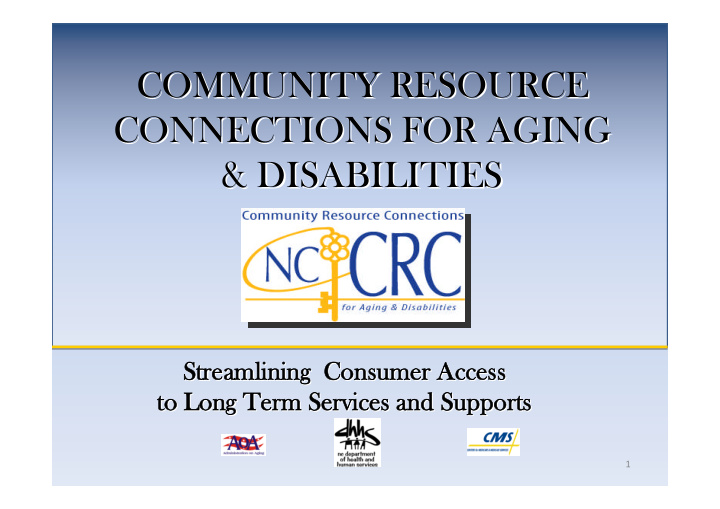



COMMUNITY RESOURCE COMMUNITY RESOURCE CONNECTIONS FOR AGING CONNECTIONS FOR AGING & DISABILITIES & DISABILITIES Stre treaml amlining Consumer umer Acce ccess Stre treaml amlining Consumer umer Acce ccess to Long Term to erm Serv ervices ces and and Sup uppo ports rts to Long Term to erm Serv ervices ces and and Sup uppo ports rts 1
Demographic Changes • NC in the midst of significant demographic change • The state’s 2.3 million baby boomers are beginning to retire • NC has the highest % of seniors living in rural areas among the most populous states 2
Percent of NC Population Age 65+ in 2000 12% or less 12.1% to 13.0% 13.1% to 14.4% Older Adults were 12.0% 14.5% to 15.9% of NC population More than 16% 3
Percent of Population Age 65+ North Carolina projected 2030 12% or less 12.1% to 13.0% 13.1% to 14.4% Older Adults projected to be 14.5% to 15.9% 17.7% of NC population More than 16% 4
Disability in North Carolina • NC has a higher average rate of people with disabilities* – 7.4% of children ages 5-20 as compared to 6.5% nationally – 15.1% of individuals ages 21-64 as compared to 13% nationally – 43.5% of individuals age 65 or older as compared to 41% nationally *Based on 2000 census
Percent of NC Population Ages 5+ with One or More Disabilities by County* Pasquotank Currituck Camden Ashe Alleghany Rockingham Caswell Gates Person Surry Stokes Warren Northampton Vanc 6,396 e Halifax Hertford Watauga Wilkes Granville Perquimans Forsyth Yadkin Guilford Franklin Chowan Avery Alamance Mitchell Caldwell Nash Durham Davie Iredell Orange Bertie Alexander 6,983 Marti Madison Edgecombe Yancey Washington Dare Burke Wake n Randolph Davidson Wilson Chatham Tyrrell Catawba McDowell Pitt Rowan Buncombe Haywood Johnston Hyde Greene Lee Lincoln Rutherford Harnett Beaufort Cabarrus Moore Stanly Wayne Henderson Graham Jackson Swain Cleveland Polk Lenoir Montgomery Gaston Macon Sampson Craven Mecklenburg Cumberland Transylvania Pamlico Hoke Clay Anson Jones Union Richmond Cherokee Duplin Onslow Scotland Robeson Bladen Carteret Pender Columbus More than 30.0% New Hanover Brunswick 25.0 to 29.9% 20.0 to 24.9% Highest %: Northampton—32.0% Lowest %: Orange—12.9% Less than 20.0% * Based on 2000 census data
2001 NC Institute of Medicine Recommendations: Entry into the System • North Carolina’s long-term care system should be accessible and understandable for both public and private pay consumers, and uniform for all in need of long-term care services (priority).
2001 NC Institute of Medicine • The North Carolina DHHS should develop a “uniform portal of entry” system for long-term care services in which confidentiality of information is ensured (priority).
“Lay of the Land” • Long-term services and supports are funded by numerous sources, administered by multiple agencies, and have complex, fragmented, and often duplicative intake, assessment, and eligibility functions. 9
• Determining how to obtain services is difficult both for persons who qualify for publicly funded support and for those who can pay privately. 10
• A uniform, coordinated system of information and access for all persons seeking long-term support will minimize confusion, enhance individual choice, be cost efficient, and support informed decision-making. 11
National Implementation: Aging and Disability Resource Centers FY 2003 ADRC FY 2005 ADRC FY 2008 ADRC FY 2004 ADRC
What is objective of the ADRC Initiative? To have Aging and Disability Resource Centers in every community serving as highly visible and trusted places where people of all incomes and ages can get information on the full range of long term support options and a uniform point of entry for access to public long term support programs and benefits.
History of ADRC/CRC in NC 2004 NC was awarded ADRC Grant (3yrs) Forsyth & Surry Counties served as pilots 2006 ADRC was included in the language of the reauthorization of the Older Americans’ Act 2007 NC Systems Transformation Grant
15
Required Functions for NC Programs Access 16
The program Is NOT! • Necessarily a new physical location • A new organization or a business • A change in program management responsibilities or eligibility criteria • A replacement of existing services 17
Recommend
More recommend